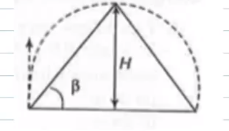A particle is thrown over a triangle from one end of a horizontal base and after grazing the vertex falls on the other end of the base. If αandβ be the base angles and θ the angle of projection, prove that tanθ=tanα+tanβ .
Let ABC be the triangle with base BC. Let h be the height of the vertex A above BC. If AM is the perpendicular drawn on base BC from vertex A, then tan∝=h/a and tanβ=H/B, where BM=aandCM=b.
Since A(a,h) lies on the trajectory of the projectile,
y=xtanθ(1−xR) ...(i)
Therefore, it should satisfy (i) i.e.,
h=atanθ(1−aa+b)[∵Ran≥,R=a+b]
ha=tanθ[ba+b]
⇒tanθ=ha+hb=tan∝+tanβ
Hence, proved.
 .
.
Topper's Solved these Questions
- KINEMATICS-2Book:CENGAGE PHYSICS ENGLISHChapter:KINEMATICS-2Exercise:Solved Examples
Explore 7 Videos
- KINEMATICS-2Book:CENGAGE PHYSICS ENGLISHChapter:KINEMATICS-2Exercise:Exercise 5.1
Explore 15 Videos
- KINEMATICS-1Book:CENGAGE PHYSICS ENGLISHChapter:KINEMATICS-1Exercise:Integer
Explore 9 Videos
- KINETIC THEORY OF GASESBook:CENGAGE PHYSICS ENGLISHChapter:KINETIC THEORY OF GASESExercise:Compression
Explore 2 Videos
Similar Questions
A particle is thrown over a triangle from one end of a horizontal base and after grazing the vertex falls on the other end of the base. If 30∘and60∘ be the base angles and θ the angle of projection then tanθ is
View SolutionIf cosθ=cosα−cosβ1−cosαcosβ,prove that tanθ2=±tanα2cotβ2.
View SolutionIf αandβ are roots of the equation acosθ+bsinθ=c, then find the value of tan(α+β).
View SolutionA shell fired from the base of a mountain just clears it. If α is the angle of projection, then the angular elevation of the summit β is

View SolutionIf α and β are acute such that α+β and α−β satisfy the equation tan2θ−4tanθ+1=0, then (α,β) =
View Solutionαandβ are acute angles and cos2α=3cos2β−13−cos2β then tanαcotβ=
View SolutionTwo particles are projected at the same instant from the same point at inclinations α and β to the horizontal. If they simultaneously hit the top and bottom of a vertical pole subtending angle θ at the point of projection , find (tanα−tanβ).
View SolutionIf tanβ=cosθtanα, then prove that tan2θ2=sin(α−β)sin(α+β).
View SolutionTwo parallel straight lines are inclined to the horizon at an angle ∝. A particle is projected from a point mid way between them so as to graze one of the lines and strikes the other at right angle. Show that if θ is the angle between the direction of projection and either of lines, then tanθ=(√2−1)cot∝.
View SolutionA train travelling on one of two intersecting railway lines, subtends at a certain station on the other line, an/ angle α when the front of the carriage reaches the junction and an angle β when the end of the carriage reaches it. Then, the two lines are inclined to each other at an angle θ, show that 2cotθ=cotα−cotβcotα+cotβ
View Solution